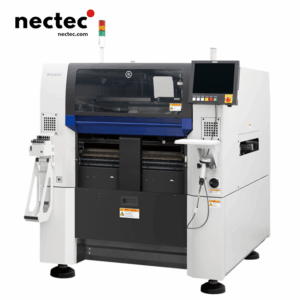In the dynamic landscape of manufacturing, automation plays a pivotal role in enhancing efficiency and precision. At the forefront of this automation revolution are pick and place machines. These sophisticated devices, which are engineered to source components from one location and position them with precision in another, are particularly crucial in sectors ranging from electronics to pharmaceuticals. This article delves into the evolution of pick and place machines, their types, applications, and the remarkable impact they have had on various industries.
Geschiedenis van pick-and-place-machines
The inception of pick and place technology can be traced back to the early 1960s. Initially, these machines were rudimentary devices, often operated manually, that struggled with speed and accuracy. However, the introduction of robotic technology in the 1980s dramatically transformed the capabilities of pick and place machines. With advancements in programming, hardware, and sensor technology, modern pick and place machines have evolved into sophisticated automated systems capable of handling an array of materials and components.
Soorten pick-and-place-machines
Pick and place machines are versatile and can be categorized based on their design and functionality. The primary types include:
1. Cartesian Pick and Place Machines
Cartesian machines use a three-axis system (X, Y, and Z axes) to move an arm. This type is ideal for applications that require straightforward paths and high precision. They are often employed in industries where speed and accuracy are paramount.
2. SCARA Pick and Place Machines
The SCARA (Selective Compliance Assembly Robot Arm) robots can provide exceptional speed and precision, particularly in horizontal movements. SCARA machines are widely used in assembly lines where components need to be placed in fixed positions with remarkable speed.
3. Delta Pick and Place Machines
Delta robots feature a unique design with three arms connected to a common base. They are incredibly fast and agile, making them perfect for applications that require high-speed operations, such as food packaging and electronic assembly.
Core Applications of Pick and Place Machines
Various industries benefit significantly from the inclusion of pick and place machines. These applications include:
1. Elektronica productie
In the electronics sector, pick and place machines are used to assemble circuit boards. They accurately place components onto PCBs, drastically reducing the likelihood of error compared to manual assembly. This enhanced accuracy contributes to the quality and reliability of electronic devices.
2. Voedingsindustrie
Pick and place machines play a vital role in the food industry, particularly in packaging. They enable the efficient handling of food products, ensuring they are placed in the correct containers. This automation not only increases productivity but also minimizes contamination risks.
3. Farmaceutica
In the pharmaceutical industry, these machines are crucial for the packaging of drugs. They ensure that products are placed in the correct packaging quickly and hygienically, conforming to strict industry regulations.
Voordelen van het implementeren van pick-and-place machines
Incorporating pick and place machines can yield several substantial benefits:
1. Verbeterde efficiëntie
Unlike manual labor, automated systems can operate continuously without interruption. This durability allows manufacturers to achieve higher output rates, significantly outperforming traditional methods.
2. Verbeterde precisie
Modern pick and place machines offer exceptional precision, which is vital in sectors where tolerances are tight. Using advanced sensors and vision systems, these machines can precisely position small components, reducing waste and the need for rework.
3. Lagere arbeidskosten
By automating the pick and place process, companies can reduce reliance on manual labor, leading to diminished labor costs. Additionally, automation reduces human error, further decreasing waste and efficiency losses.
Uitdagingen en overwegingen
While pick and place machines offer numerous advantages, companies must also be cognizant of certain challenges:
1. Initiële investering
The cost of acquiring high-quality pick and place machines can be substantial. Companies must weigh the initial investment against long-term gains in efficiency and precision.
2. Onderhoud en stilstand
Automation systems require regular maintenance to ensure they operate optimally. Companies must have a robust maintenance plan in place to minimize downtime.
3. Opleidingsvereisten
Employees must be trained to operate and maintain these machines properly. This additional training can require time and resources, which can be a barrier for some organizations.
De toekomst van pick-and-place-machines
The landscape of pick and place machines is continuously evolving. With the advent of AI and machine learning, these machines are becoming smarter and more adaptable. Innovations in robotics are set to enhance their versatility, allowing them to handle a wider range of products and tasks.
Furthermore, the integration of IoT (Internet of Things) technology enables these machines to communicate with other devices, facilitating real-time monitoring and diagnostics. This connectivity can greatly improve efficiency, reduce unexpected downtime, and optimize production lines.
Laatste gedachten
As manufacturing trends continue to move towards greater automation, pick and place machines will undoubtedly play an increasingly critical role. Their ability to enhance efficiency, improve precision, and reduce labor costs makes them a valuable asset across various industries. Embracing the capabilities of these machines will be imperative for companies striving to maintain competitiveness in an automated world.






